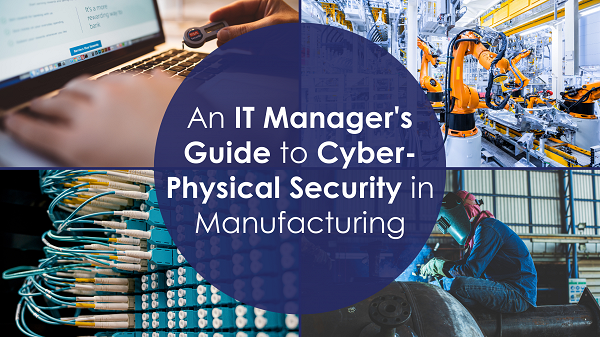An IT Manager's Guide to Cyber-Physical Security in Manufacturing

In today’s rapidly evolving digital landscape, the convergence of Information Technology (IT) and Operational Technology (OT) has become a critical focus for manufacturing organisations. This integration, while offering numerous benefits, also presents unique security challenges that IT managers must address to safeguard their operations.
The manufacturing sector is increasingly becoming a prime target for cyber threats. According to Make UK, approximately half of manufacturers have fallen victim to cybercrime in the past year. This alarming statistic underscores the urgent need for robust cyber-physical security measures in the industry.
The Evolving Threat Landscape
The threat landscape for manufacturers has grown more complex and dangerous. Cyber extortion attacks, ransomware, and supply chain vulnerabilities are on the rise, posing significant risks to production processes, intellectual property, and business continuity.
Recent data from the Cyber Security Breaches Survey 2024 reveals that manufacturing firms in the UK are experiencing an uptick in sophisticated cyber-attacks. These incidents not only lead to financial losses but also result in production downtime and reputational damage.
Other blogs you may be interested in:
- How to Resolve Cyber Vulnerabilities with PREPARED Methodology Without Panic
- Navigating Client Security Mandates: A Roadmap for Manufacturing Firms
- How Procurement or Facilities Managers Can Close Security Gaps in Manufacturing with Ease
Understanding Cyber-Physical Security
Cyber-physical security represents a holistic approach to protecting both digital assets and physical operations. It’s about creating a unified security strategy that addresses the interconnected nature of modern manufacturing environments.
Security Convergence: The Key to Comprehensive Protection
Security convergence involves integrating physical and cyber security technologies to create a more robust defence against threats. This approach allows for:
- Improved automation and visibility of production data
- Faster implementation of Smart Manufacturing solutions
- More efficient energy and resource usage through integrated analytics
By adopting a converged security model, manufacturers can better protect their valuable assets, from intellectual property to physical infrastructure.
The PREPARED Methodology: A Framework for Success
Our unique PREPARED methodology offers a comprehensive approach to implementing cyber-physical security in manufacturing environments:
- Pre-Assess: Assess your current security posture
- Risk Assessment: Identify and evaluate potential threats
- Evaluate: Analyse existing controls and their effectiveness
- Prevent: Implement proactive security measures
- Action: Develop and execute risk treatment plans
- Re-Train: Train staff on security best practices
- Exercise: Test staff on security best practices
- Decide: Continuously monitor and improve security measures
This methodology ensures a systematic approach to security that addresses both cyber and physical aspects of your manufacturing operations.
Other blogs you may be interested in:
- Securing Legacy Equipment: Strategies to Prevent Criminal Activity in Manufacturing
- 7 Cutting-Edge Cyber-Physical Security Solutions for Uninterrupted Manufacturing Operations
- The PREPARED Approach: A Comprehensive Guide to Cyber-Physical Security for Manufacturers
Implementing Cyber-Physical Security: Challenges and Considerations
While the benefits of cyber-physical security are clear, implementation can present challenges:
- Legacy systems: Many OT systems run on outdated hardware, making integration with modern IT security solutions complex.
- Skills gap: There’s often a lack of expertise in both IT and OT security within organisations.
- Cost concerns: Initial investment in comprehensive security solutions can be significant.
However, the long-term benefits far outweigh these challenges. A robust cyber-physical security strategy can prevent costly breaches, protect valuable IP, and ensure business continuity.
Best Practices for IT Managers
- Conduct regular risk assessments to identify vulnerabilities in both IT and OT systems.
- Implement a zero-trust security model across your entire network.
- Ensure all systems, including legacy OT equipment, are regularly patched and updated.
- Develop and test incident response plans that address both cyber and physical security events.
- Invest in employee training to create a security-aware culture.
- Comply with relevant UK regulations, such as the NIS Regulations and GDPR.
Other blogs you may be interested in:
- How Our Methodology Boosts Operational Efficiency and Security
- Navigating Security Challenges During Global Instability: Why Choose Us https://bit.ly/3U3nmqx
- Making the Right Choice: Why Core Values Matter in Your Security Partner https://bit.ly/3zrDVF0
The Future of Manufacturing Security
As we look ahead, the integration of cyber-physical systems will only deepen. The UK government’s initiative to enable a national cyber-physical infrastructure demonstrates the importance of this convergence. By embracing comprehensive cyber-physical security solutions now, manufacturers can position themselves at the forefront of this evolution, ensuring resilience, efficiency, and competitive advantage in the years to come.
In conclusion, as an IT manager in the manufacturing sector, your role in safeguarding both digital and physical assets has never been more crucial. By adopting a holistic approach to cyber-physical security, you can protect your organisation’s operations, intellectual property, and reputation while driving innovation and growth. Remember, in today’s interconnected world, security is not just about preventing breaches—it’s about enabling your business to thrive securely in the digital age.
Do you want to learn more about cyber-physical security in manufacturing? Join our next webinar here:
This content has been generated with the assistance of artificial intelligence (AI). While AI technology was used to draft and develop the initial content, it has been thoroughly reviewed, edited, and fact checked by Luke to ensure accuracy and relevance. We strive to provide high-quality and trustworthy information, but please be aware that AI-generated content may contain errors or omissions. We take full responsibility for the final content presented here and are committed to maintaining transparency and integrity in our use of AI technology.





